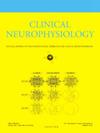精神病患者看东西:对模糊视觉刺激的早期神经反应中θ波能量的降低预示着知觉扭曲
IF 3.6
3区 医学
Q1 CLINICAL NEUROLOGY
引用次数: 0
摘要
目的探讨精神障碍患者知觉障碍可能的神经来源。方法:精神分裂症和双相情感障碍合并精神病患者(n = 40)、他们的同胞(n = 17)和健康对照(n = 27)在初级视觉皮质加工需求中观察到等效的模糊物体刺激,从而识别出发生在基本感觉加工之外的神经异常。采集脑磁图,用时频分析方法量化神经振荡。结果精神分裂症患者枕叶皮层早期θ波反应减少,顶叶皮层晚期α / β非同步化减少。减少的θ波与更多的分裂型特征和自我报告的知觉异常有关。α / β非同步化程度越低,阴性症状越严重。结论精神分裂症患者的视觉皮层异常表现为早期枕波振荡减少。这种自下而上的感觉加工受损与日常感知异常有关。精神分裂症患者后期α / β去同步性的减弱可能反映了从默认模式中脱离到访问促进感知的自上而下机制的困难。早期的感觉信号通过θ波段振荡传递,后期的语义处理通过α / β振荡的去同步参与,有助于精神分裂症的模糊物体检测和知觉障碍。本文章由计算机程序翻译,如有差异,请以英文原文为准。
Seeing things in psychosis: Reduced theta power in early neural responses to ambiguous visual stimuli predicts perceptual distortions
Objective
In this study we aimed to identify possible neural origins of perceptual disturbances in psychotic disorders.
Methods
Individuals with schizophrenia and bipolar disorder with psychosis (n = 40), their biological siblings (n = 17), and healthy controls (n = 27) viewed ambiguous object stimuli equivalent in primary visual cortical processing demands, allowing for identification of neural abnormalities occurring beyond basic sensory processing. Magnetoencephalography was collected and neural oscillations were quantified using time–frequency analysis.
Results
Individuals with schizophrenia showed reduced early theta responses over occipital cortex and diminished late desynchronization of alpha/beta in select conditions over parietal cortex. Reduced theta was associated with more schizotypal traits and self-reported perceptual anomalies. Less alpha/beta desynchronization was marginally associated with greater negative symptoms.
Conclusions
Visual cortical anomalies in schizophrenia beyond primary visual cortex are reflected in reduced early occipital theta oscillations. This impaired bottom-up sensory processing is related to everyday perceptual abnormalities. Diminished later alpha/beta desynchronization in schizophrenia may reflect difficulty disengaging from default mode to access top-down mechanisms that facilitate perception.
Significance
Early sensory signals, communicated through theta-band oscillations, and later semantic processing, engaged through the desynchronization of alpha/beta oscillations, contribute to ambiguous object detection as well as perceptual disturbances in schizophrenia.
求助全文
通过发布文献求助,成功后即可免费获取论文全文。
去求助
来源期刊

Clinical Neurophysiology
医学-临床神经学
CiteScore
8.70
自引率
6.40%
发文量
932
审稿时长
59 days
期刊介绍:
As of January 1999, The journal Electroencephalography and Clinical Neurophysiology, and its two sections Electromyography and Motor Control and Evoked Potentials have amalgamated to become this journal - Clinical Neurophysiology.
Clinical Neurophysiology is the official journal of the International Federation of Clinical Neurophysiology, the Brazilian Society of Clinical Neurophysiology, the Czech Society of Clinical Neurophysiology, the Italian Clinical Neurophysiology Society and the International Society of Intraoperative Neurophysiology.The journal is dedicated to fostering research and disseminating information on all aspects of both normal and abnormal functioning of the nervous system. The key aim of the publication is to disseminate scholarly reports on the pathophysiology underlying diseases of the central and peripheral nervous system of human patients. Clinical trials that use neurophysiological measures to document change are encouraged, as are manuscripts reporting data on integrated neuroimaging of central nervous function including, but not limited to, functional MRI, MEG, EEG, PET and other neuroimaging modalities.
 求助内容:
求助内容: 应助结果提醒方式:
应助结果提醒方式:


